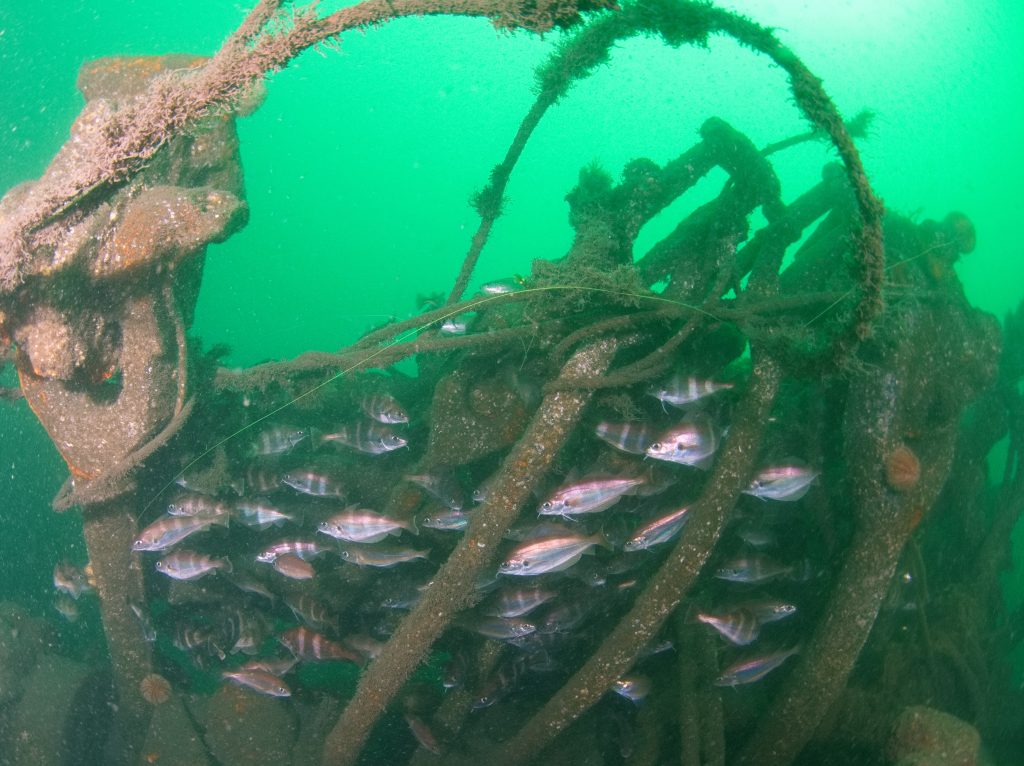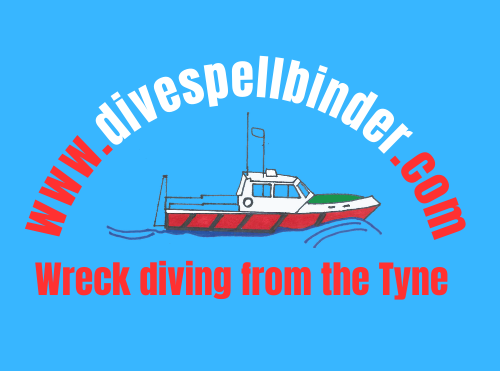Wreck Diving
This section provides examples of the many wrecks there are to dive out of the Tyne onboard Spellbinder II
Oslo Fjord
The Oslo Fjord is possibly the most dived wreck out of the Tyne. It lies at a maximum depth of about 14 metres, so at slack is a good dive for just about any diver. She was a liner of the Norwegian – American Line, converted in to a troop ship in 1940. Not long after, she hit a mine and was sunk close to the entrance of the Tyne.
As a dive, the Oslo Fjord is very interesting, but can be a little difficult to orientate on, as the wreck lies 90 degrees to, and partially under the wreck of the Eugena Chandris. However there are plenty of things to see on this dive, including boilers, engine blocks, pistons, metal sheets and lots of bits of twisted metal.
If it is marine life you are in to, then there is plenty to see here too, including angler fish, Yarrell’s blenny, nudibranches and lots of crustaceans such as crabs and lobsters.

Lonclara
The Lonclara was a port of London dredger, powered by steam which hit a mine and sank in January 2014. She lies in approximately 18 metres, on a mixed seabed. When diving this wreck Allan generally shots the boilers, so you can descend the shot, then orientate yourself. The Stern can easily be found by following the prop shaft, with a few plates still upstanding – there is still a propeller in the wreckage too.
The bow is much less discernible, but the journey towards the bow takes you past lots of bits of wreckage 1 – 2 metres proud of the seabed. A large school of bib are often to be found just chilling out around and within the wreckage too. There are also lots of crabs, lobsters and if you look hard octopus can often be spotted.

UC32 - Submarine
This wreck is that of a U-boat, which was only rediscovered by divers in 1989. She was sunk in 1917 while on mine laying duties, so for many years she lay on the seabed at about 13 metres depth, still with her explosive cargo intact. In 1989, shortly after her rediscovery she was “made safe”, in other words they blew her up again.
That said, the UC32 does make for an interesting dive (as long as you have a good team of divers that don’t kick up the silty seabed). Many parts of the submarine can still be seen, including the hydroplanes, tower and torpedo tubes. She is broken in to two main parts, but if you are prepared to look around there are also a number of pieces scattered near by on the seabed too.

Cider Wreck
Known locally as the cider wreck owing to the number of cider bottles found here, this wreck is an excellent dive. She sits in about 26 metres of water and should be dived on or about slack.
The boilers and engine block stand tall of the sea bed, providing a home for a huge shoal of bib. You can swim through the gaps between the engine and boiler, emerging directly in to a shoal of the silvery fish.
The wreck is quite easy to orientate on, allowing you in a single dive to fin out to both the stern and bow areas. Keep your eyes open as many surfaces are covered with dead men’s finger soft corals, hydroids and anemones, between which you can find lobsters, fish and on occasion octopus too.

Hanne
The Hanne was a Danish steamship which was built in 1905, and 230ft long. She struck a mine in December 1939 and sunk, breaking in to two parts and lying in about 20 metres of water. When diving this wreck Allan always manages to shot the boilers, which is good for orientation as the wreckage is well dispersed across the sea bed.
The boilers and compound engines do make for quite an impressive feature. From here you can follow the propeller shaft out across the keel ribs of the vessel, some of which become periodically buried by sand. A large iron propeller still lies flat on the seabed close to the stern, which is still relatively intact and still stands proud 2 – 3 metres of the seabed.

Pandora
In 1939 the Pandora was being towed by tugs up the North East coast when she struck a mine and rapidly sank, fortunately without loss of life. Despite extensive commercial salvage, the wreck of the Pandora still offers an excellent dive, lying in about 20 metres of water.
Allan generally shots the boilers, so if you swim around the boilers you have two options: 1. Follow the propeller shaft towards the stern, or 2. much more fun, find the anchor that lies adjacent to the boiler, then follow the shaft of the anchor towards the bow. This does involve a bit of a swim of faith, over scattered lumps of coal and metal sheeting. But once at the bow, you will be rewarded.
The bow sits about 4-5 metres of the seabed and is covered with life. Inside there is a large shoal of bib, sometimes with the odd poor cod too for variety. The bow has a few holes in that you can swim through and is very atmospheric.

Firelight
The Firelight was a 1143-ton British steamship owned by The Gas Light & Coke Co and built as the ROOKWOOD in 1896 by J.Blumer & Co. at Sunderland. She was torpedoed by UC 29 on 1st May 1917. The crew all got away safely in the ship’s boats.
As a dive site, she sits in about 38-42 metres (depending on tide); with some relatively upstanding sections of wreckage to explore. One of the more interesting bits are some piles of wood shingles, which are still there, slowly washing away with tides and time. (see photo).
The bridge section of the wreck still stands about 8-9 metres above the seabed. The three cylinder, triple expansion, two boiler engine, that drove the single steel propeller can still be seen too, often covered with marine life, and unfortunately lots of lost and discarded fishing gear – a lead hunter’s heaven if you are up for it!

Eston
the wreck of the Eston lies scattered across the sea bed. She was 73 metre long, with triple expansion steam engines. She sank in 1940, on route from Hull to Blyth. She wasn’t found again until 1977, when she was found to be relatively intact.
Now she is well broken up and collapsed. Often a silty dive, after calm weather and neap tides you can easily find the boilers which are intact and full of marine life. The engine block and a few other more solid bits remain, like winching gear, often surrounded by large shoals of bib and poor cod.
The bow lies 40 metres to the north of the boilers, but we have never found it; only lots of plates spars and remains of electric wiring, being guarded by very large lobsters and some grumpy crabs!

